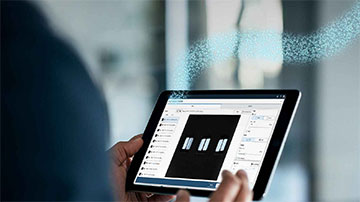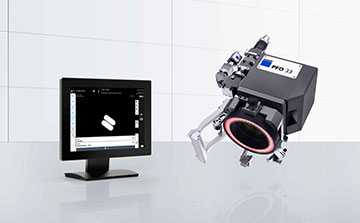
Trumpf, the behemoth international industrial-laser and machine-tool firm, announced the launch of EasyModel AI, which allows users to create an AI-driven algorithm for laser-welding processes. [Image: Trumpf]
Trumpf, the international industrial-laser and machine-tool company based in Germany, revealed on 6 June that it had developed an artificial intelligence product that it says can make laser-welding-based manufacturing processes much more efficient. The company also announced plans to demonstrate the new AI-driven solution at Laser World of Photonics, the world’s largest photonics trade show, scheduled from 27 to 30 June in Munich, Germany.
In a virtual press event held on the same day, Christian Schmitz, Trumpf’s CEO for Laser Technology, and Florian Kiefer, the company’s head of services product management for laser technology and an AI expert, talked not only about the firm’s new product but also how the company envisions AI’s influence on laser-enabled processes—and society as a whole.
“In the future, we want to use AI to raise the overall system of lasers, optics, sensor technology and software to a new level of performance,” said Schmitz in the press release announcing the AI application. “We are therefore pushing ahead with the development of further AI solutions that will make laser processes in industry even more powerful and profitable.”
EasyModel AI
After training, EasyModel AI creates an AI filter that can be used for Trumpf’s VisionLine Detect image-processing system. [Image: Trumpf] [Enlarge image]
Typically, in a manufacturing process that involves a laser-welding step, a sensor must precisely position a laser beam to ensure that the seams will be in the right place. However, interference from impurities such as dirt or scratches, reflective materials like copper, and dim work environments can jeopardize the positioning.
To solve this issue, Trumpf introduced AI to its sensor system to improve image processing. The resulting product, EasyModel AI, generates an algorithm and an AI filter that can be used in the firm’s VisionLine Detect system to reduce the effect of interference.
Although no programming skill is required, an operator must train the AI before using the product. To do so, the user needs to mark a relevant component area in a corresponding image. According to the press release, using the EasyModel AI system will be as simple and intuitive as using software or smartphone apps to paint and draw.
Faster and less dependent
Thinking about how AI can improve laser processes more generally, Schmitz said at the press event that its involvement would make a production line a lot faster and less dependent on humans. And as for finding the right parameters for sensors—for example, an OCT sensor with a wide variety of parameters that users have to choose—an AI approach can narrow the ranges, helping operators to find the right ones quicker than they could on their own, said Kiefer.
What sets Trumpf and its AI technology apart is the amount of data that the company has and its understanding of how to handle and get the most out of them, noted Kiefer.
What sets Trumpf and its AI technology apart is the amount of data that the company has and its understanding of how to handle and get the most out of them, noted Kiefer. Combining these data with AI can help customers particularly with highly dynamic processes, such as hairpin welding, where the users need to make decisions quickly and correctly, for example, regarding the amount of laser power required, according to Schmitz.
In the near future, Trumpf will be bringing AI solutions to three areas, said Kiefer. One is optimizing sensors to better detect the parts that need welding and more accurately position the laser. Another aim is to increase the usability of Trumpf’s products, especially those that are more complex. Finally, further down the road, Kiefer expects AI to help with quality inspection—getting to a point where the process knows how to operate itself.
“In [the] long term, I think we can make it easier for customers to use the laser,” added Schmitz. “And my dream is always that someone can just buy a laser without having deep knowledge about the laser process—but the laser knows the processes.” He imagines that, in the future, even customers who have no idea how to use a laser would use it because AI would make the process so simple.
Not a job killer, but a job changer
While both men believed AI would allow laser-based production steps to become more independent of human input, neither Schmitz nor Kiefer thought that would mean empty fabrication plants. “Because in all our approaches, the human is very important to actually train the AI,” argued Kiefer. “So there is no AI without the human.”
“Because in all our approaches, the human is very important to actually train the AI,” argued Kiefer. “So there is no AI without the human.”
But both men conceded that the introduction of AI to laser-based manufacturing will affect jobs to some degree. Instead of having to focus on specific procedures, such as welding batteries or cutting sheet metal, and on ways to ramp up those steps, customers can spend their time and energy performing other tasks. “It will not be a job killer, it will be a job changer,” commented Schmitz.
As for societal concerns surrounding AI, Schmitz agreed that “we need some clear rules, what is allowed and what is not allowed.” At the same time, he pointed out that the discussions about regulations have nothing to do with the technology itself; they are more about how humankind is using the technology. “And in the industry, I don’t have so much concerns about that,” Schmitz added.


